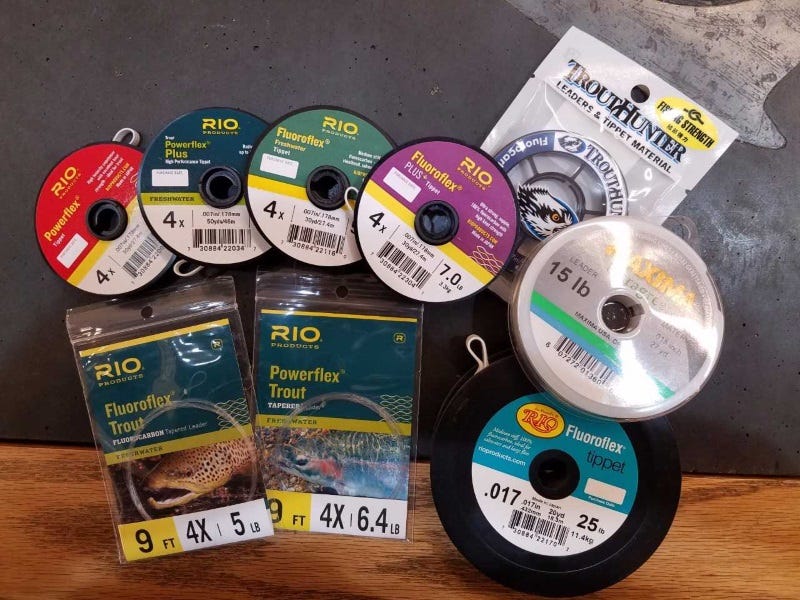Does Tippet Material Matter? Nylon Tippet vs. Fluorocarbon Tippet


Walking into a fly shop and confronting a wall of tippet material can be intimidating, especially when there are different varieties available in all sorts of strengths. That is probably the case when people see conventional nylon tippet and fluorocarbon tippet on the same wall. What’s the difference, they might ask. Here’s your answer:
Fluorocarbon is generally two to three times more expensive than nylon. Often people make their decision between the two, simply based on price, without considering what properties each material offers and what benefits those properties might have on their fishing success.
Nylon leader and tippet material has long been the standard. Nylon is strong, flexible and it generally floats. Conversely, fluorocarbon is a slightly stiffer material with a little less stretch. It’s also a little less visible in water, and it sinks. Given these characteristics, when should we choose one over the other?
Here's some of the option of tippet we have online.
Dry Flies and Selecting the Right Tippet
For dry flies, the obvious choice is nylon, because it’s buoyant and won’t pull a fly under the surface. This is especially important when fishing in riffles or broken water. But what about on smooth flowing water, such as a spring creek? Nylon is shinny and reflective on the surface of the water. Not good properties when fishing small flies for picky fish in clear water.
Because fluorocarbon (FC) can break surface tension and get underneath the film, it is far less visible to the fish. The key to using FC with dry flies is to use it only as the tippet. The idea is this: Nylon leader floats while the FC tippet sinks just enough to keep from leaving a reflective trail on the surface to the fly. A short length of FC is generally not enough to pull the dry fly under during a dead drift. With this combo, you get the benefit of using the best properties of each material.
Nymphing: Which Tippet do you Need?
For nymphing, FC has some clear advantages and I’ll start by saying that I use fluorocarbon tippet exclusively when nymphing, for these reasons. Number one is that it sinks. For that reason, less weight is needed on the leader and/or flies to achieve the desired depth. Second is the visibility factor. By using FC, I can often get away with an X size heavier than if I was using nylon.
When the Missouri River is weedy, you need 4X to have a legitimate chance to land most fish. 5X will get more bites, but it is just not going to hold up when a 20” trout runs it through a gob of green. 4X FC will still get bites on a #20 Zebra Midge and keep you fast to that fish. 4X mono, not so much.
Streamers' Tippet: Which one do you Need?
What about tippet material when fishing streamers? Here things get a little gray. Nylon has the edge in absorbing shock because it has a bit more elasticity. FC has the edge in abrasion resistance and lower visibility.
If I am swinging small streamers with a trout Spey setup during winter, I’m going to go with FC for both sink rate and visibility. The FC will sink enough to allow me to use a floating line and still get some depth. Since fish have time to inspect the fly in the slower winter flows, less visible tippet is also beneficial.
If I’m swinging flies for large steelhead or salmon, or stripping a jumbo streamer for big trout or pike, I’ll probably go with mono for the added cushion it provides on a vicious strike or sudden lunge. In these situations, tippet visibility is not a big factor. If depth is needed, that can be achieved with a sinking line.
If I am fishing in an area where abrasion resistance is a concern, I’ll go with FC, but in a heavier size, like opting for 20-pound strength FC instead of 15-pound mono. Given the lower visibility of FC, I can bump up in breaking strength and increase my abrasion resistance even more.
When Fly Fishing with Saltwater Flies: Use this Tippet
When it comes to delivering a fly to a bonefish, permit or tarpon, or any other inshore species, visibility, sink rate, strength and abrasion resistance are all key factors. FC is generally my choice for leader and tippet unless the water is very skinny or I’m fishing on the surface. Then I will opt for a mono leader with an FC tippet.
Having the right tool for the job
Nylon and fluorocarbon each have characteristics that make them valuable tools for delivering a fly to a fish. Knowing when and why to pick one over the other, or even when to combine them, sets you up with the best leader and tippet systems to catch more fish. If you’re still confused, stop into North 40 and we’ll show you the differences.
